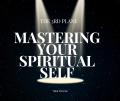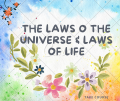
This article from a video of Rabbi Simon Jacobson discusses Kabbalah, explaining that its name means “to receive.” The Rabbi emphasizes the importance of humility and receptiveness in studying Kabbalah, contrasting this approach with the potentially harmful sensationalism and self-aggrandizement that can arise from a misunderstanding of its principles. He connects this concept of receiving with a deeper understanding of oneself and the universe, arguing that true understanding requires shedding one’s ego and embracing a student-like mindset. Jacobson uses various examples and metaphors to illustrate the importance of this approach, referencing historical figures and spiritual practices. Finally, he encourages viewers to approach Kabbalistic study with humility and a commitment to self-improvement.
Kabbalah, also spelled Qabalah, is a Jewish mystical school of thought that explores the nature of God, and is considered the foundation of mystical interpretations in Judaism. Kabbalists believe that God works in mysterious ways, but that it is possible to gain true understanding of this process and attain intimacy with God.
Frequently Asked Questions about Kabbalah
- What does the word “Kabbalah” actually mean, and why is that meaning significant?
- The word “Kabbalah” simply means “to receive” or “reception.” This is significant because the core of Kabbalistic study and practice isn’t about intellectual mastery or forceful acquisition of knowledge. Rather, it’s about positioning oneself as a humble and receptive vessel to receive wisdom, guidance, and insight from a source greater than oneself. This receptivity is paramount, and differentiates it from other forms of study.
- Why has Kabbalah, once obscure, become so popular and fashionable today?
- Kabbalah has captured public interest because human beings are naturally drawn to mystery, the hidden, and the esoteric, especially when linked to the secrets of the soul, the cosmos, and existence itself. The allure of unveiling the “blueprints” of the universe and understanding the inner workings of oneself sparks curiosity. The accessibility of information has also contributed to a greater awareness of it.
- How does Kabbalah differ from other types of learning or knowledge acquisition?
While all learning involves a receiving aspect, Kabbalah emphasizes the need to be in a constant state of receptivity. It’s less about asserting oneself and more about being a humble student, always open to learning from teachers and from the wisdom being channeled through them. This is especially important in Kabbalah due to the subtle and sensitive nature of the subject matter, similar to the precision required in delicate surgery. The mode of learning, with its humility, is as important as the information itself.
- What is the significance of the “Kabbalah mode” or the concept of “Bittle” (selflessness)?
- The “Kabbalah mode” or “Bittle” signifies a state of selflessness, humility, and receptivity. It’s about emptying oneself of ego, personal biases, and preconceived notions in order to become a clear channel for higher wisdom. This state is critical because Kabbalah deals with the inner workings of the soul and the cosmos, where even the slightest tinge of arrogance or self-interest can distort the true meaning and application of its teachings.
- Why was Kabbalah traditionally kept secret and not taught to the masses?
- Kabbalah was traditionally kept private and taught in smaller, trusted groups because its deep understanding of human nature and the cosmos could easily be misused. Without compassion, integrity, and the Kabbalah mode, an individual could become manipulative or arrogant. It’s likened to performing inner surgery: one needs a sterile and trustworthy environment because it’s handling the delicate inner workings of people and the universe.
- How does Kabbalah connect the inner and outer realms of existence? Kabbalah teaches the principle of microcosm/macrocosm, suggesting that everything that exists on a cosmic scale exists in a miniature form within the individual. This interconnectedness shows that the universe, the world, and each human are part of one large integral unity. Understanding the inner workings of oneself provides insight into the forces shaping the outer world. It shifts perspective from the surface level to the deeper forces behind it.
- What is the relationship between the “Superconscious intelligence” and the “conscious mind” in Kabbalah?
Kabbalah posits a realm called “Superconscious intelligence,” an area of wisdom beyond the ordinary conscious mind. A small bridge or window exists between these two realms, allowing insights to enter conscious awareness. This bridge can be opened through two means: effort and commitment to understanding, and through selflessness (“Bittle”). Arrogance, on the other hand, closes this bridge, showing the importance of a humble state for receiving guidance.
- What is the contemporary relevance of Kabbalah, and how can it be integrated into modern life?
- Although we live in a more complex, less “pure” world, Kabbalah has become essential for finding spiritual resources. As the world faces unprecedented challenges, its teachings offer deep therapeutic, psychological, and spiritual insights that can guide individuals toward healthier relationships, increased potential, and a fresh perspective on existence. Through study, prayer, and good deeds, we can cultivate the humility and receptivity necessary to allow the transformative wisdom of Kabbalah to emerge in our lives, bridging the inner and the outer, leading to both personal and global growth.

Quiz
Instructions: Answer each question in 2-3 sentences.
- What does the word “Kabbalah” mean, and why is this meaning significant to understanding the teachings?
- According to the text, why do people find Kabbalah intriguing?
- What are the two reasons that the text provides for the need for a teacher/student relationship in Kabbalah?
- What does it mean to be in a “receptive mode,” and why is this important for studying Kabbalah?
- How does the text differentiate between learning practical skills (like cooking) and learning about the heart and soul?
- Why was Kabbalah traditionally kept secret, according to the text?
- How does the concept of microcosm and macrocosm relate to Kabbalah?
- What is the difference between “knowing” and “becoming” knowledge, and how does this apply to the study of Kabbalah?
- How do the examples of Abraham and music help illustrate the idea of “letting go” in the context of Kabbalah?
- What are some ways the text suggests to cultivate the “Kabbalah mode” in everyday life?
Quiz Answer Key
- The word “Kabbalah” means “to receive” or “reception.” This is significant because it highlights the central idea that one must be receptive to divine wisdom rather than actively seeking or acquiring it.
- People are drawn to Kabbalah because it offers access to the mysterious and the unknown, promising secrets of the soul, the cosmos, and the blueprint of existence. It taps into a human desire to understand what is hidden from plain sight.
- The text provides two reasons for the teacher/student relationship: the teachings need to be passed down in a pure form to preserve their integrity, and the student needs to be in a “receiving mode” to truly understand the material.
- Being in a “receptive mode” means emptying oneself of ego and preconceived notions to become an open channel for spiritual wisdom. This is critical because it allows one to receive knowledge without distortion from personal biases.
- Learning practical skills like cooking is different than learning matters of the heart and soul because the teacher is a vessel for a recipe but does not necessarily have to embody the qualities of the message. Learning matters of the heart requires the teacher to live with integrity and be an example of the message being taught.
- Kabbalah was traditionally kept secret not to be confidential but because it’s easy to abuse when you understand the inner workings of a person. If taught incorrectly, a person could manipulate or harm others.
- The concept of microcosm and macrocosm suggests that everything that exists in the larger universe (macrocosm) is reflected in a miniature form within us (microcosm). This means that understanding ourselves can lead to understanding the universe as a whole.
- “Knowing” knowledge is acquiring information, but “becoming” knowledge means internalizing it and allowing it to transform your very being. In Kabbalah, the goal is not just to know about spiritual concepts, but to live them.
- The story of Abraham illustrates that the search for truth can lead to the need to stop the active search and “let go” to allow the truth to emerge naturally. The music example shows how we can only experience the true beauty and transformative power of an experience by letting go of our analytical control.
- Some ways to cultivate the “Kabbalah mode” include studying with a humble attitude, practicing selflessness and compassion, engaging in prayer, and performing good deeds. It means living a life that refines one’s character and opens one’s soul to greater spiritual insight.
Essay Questions
- Discuss the paradox of Kabbalah being both a hidden tradition and now widely accessible. Analyze the benefits and potential pitfalls of this shift in light of the text.
- Explore the concept of “Kabbalah mode” as presented in the text, contrasting it with conventional approaches to learning and knowledge acquisition. How does the text portray the importance of this approach to studying the material?
- Analyze how the text utilizes metaphors (such as the surgeon, the recipe, and the child hiding) to illustrate complex concepts in Kabbalah.
- Based on the information in the text, discuss how Kabbalah connects the inner workings of the individual to the structure of the cosmos.
- How does the text position Kabbalah as a path for personal transformation and spiritual growth, and what practical steps are suggested for embarking on this journey?
Glossary of Key Terms
Kabbalah: The word means “to receive” or “reception” and refers to an ancient mystical tradition that explores the inner dimensions of existence. It emphasizes the importance of receiving divine wisdom and being in a receptive state of mind.
Receptive Mode: A state of mind where one empties oneself of ego, preconceived notions, and personal agendas to be able to act as a conduit for spiritual insight, knowledge, and wisdom. This state is critical for genuine learning in Kabbalah.
Microcosm/Macrocosm: The idea that the universe (macrocosm) is reflected in miniature within the individual (microcosm), and that by understanding one we can understand the other. This interconnectedness highlights the idea that the cosmos is both within and beyond our grasp.
Bittle: The concept of selflessness, humility, and surrender to a higher truth. In the context of Kabbalah, Bittle is described as a critical attitude for genuinely learning about spiritual matters.
Ego: The sense of self that gets in the way of spiritual understanding when it is not under control or in a humble state. Kabbalah emphasizes the need to transcend the ego to connect with deeper truths.
Inner Workings: Refers to the subtle layers of existence, both within the human being (mind, soul, emotions) and within the structure of the universe.
Spiritual DNA: Metaphorically refers to the underlying spiritual blueprint of the human being and the universe. Kabbalah seeks to understand these deeper forces.
Super-Conscious: An area of consciousness beyond the conscious mind where higher wisdom resides. This is the source of inspiration, intuition, and deeper truths.
Esoteric: Refers to knowledge that is understood by only a small number of people with specialized knowledge. In the context of this text, esotericism relates to the inner secrets of the human and cosmic experience.
Messianic Age: A future era of peace, unity, and spiritual enlightenment, anticipated in Jewish tradition and connected to the spreading of spiritual knowledge.convert_to_textConvert to source
- ancient wisdom
- Bittle
- Consciousness
- esoteric
- humility
- inner peace
- Jewish mysticism
- Kabbalah
- Kabbalah explained
- meaningfullife
- meditation
- microcosm macrocosm
- Personal Growth
- Rabbi Shimon Bar Yochai
- Rabbi Simon Jacobson
- receive
- secrets of the universe
- self-help
- soul
- spiritual growth
- Spirituality
- Super conscious
- Zohar
Bible Search
 God Powered Affirmations and Prayers
God Powered Affirmations and Prayers IAM Higher Spiritual Powers
IAM Higher Spiritual Powers Becoming Ultimate Masters
Becoming Ultimate Masters The Power of the Mind and Positive Thought
The Power of the Mind and Positive Thought Achieving and Retaining Abundance and satisfaction
Achieving and Retaining Abundance and satisfaction The 3rd Plane: Mastering Your Spiritual Self
The 3rd Plane: Mastering Your Spiritual Self Secrets to a Successful Life
Secrets to a Successful Life The Great News: Understanding the God within You
The Great News: Understanding the God within You The laws of the Universe and the Laws of LifeSpirituality
The laws of the Universe and the Laws of LifeSpirituality
 Gerald BusingeOut-of-Body Experiences and the Nature of Reality by Darius J Wright
Gerald BusingeOut-of-Body Experiences and the Nature of Reality by Darius J Wright Gerald BusingeOut-of-Body Experiences and the Nature of Reality by Darius J Wright
Gerald BusingeOut-of-Body Experiences and the Nature of Reality by Darius J WrightKathieOut-of-Body Experiences and the Nature of Reality by Darius J Wright
Harry StevensonOut-of-Body Experiences and the Nature of Reality by Darius J Wright
The 3rd Plane: Mastering Your Spiritual Self
Jáckson Patrick Nnamdi ÁchusimThe Eye of the I: from which nothing is hidden by David R Hawkins
The laws of the Universe and the Laws of Life
The Science of Getting Rich - The Ultimate MastersHow to Observe the Cosmic Law: Guidance from the Angels and Spiritual Hierarchy
 Through the Gates of Good: James Allen’s Path to RighteousnessPower of God
Through the Gates of Good: James Allen’s Path to RighteousnessPower of God Thought Vibration and the Law of AttractionPhysical wellbeing
Thought Vibration and the Law of AttractionPhysical wellbeing Think and Grow Rich: Napoleon Hill’s PrinciplesMental wellbeing
Think and Grow Rich: Napoleon Hill’s PrinciplesMental wellbeing Tao Te Ching (McDonald Translation)General
Tao Te Ching (McDonald Translation)General Secret Door to Success: Spiritual Laws and Practical WisdomPhysical wellbeing
Secret Door to Success: Spiritual Laws and Practical WisdomPhysical wellbeing I AM Discourses: The Seven Mighty ElohimProsperity
I AM Discourses: The Seven Mighty ElohimProsperity The Power of the Spoken Word: Scovel Shinn’s GuidePower of God
The Power of the Spoken Word: Scovel Shinn’s GuidePower of God Power Versus Force: Anatomy of ConsciousnessMental wellbeing
Power Versus Force: Anatomy of ConsciousnessMental wellbeing Out From The Heart: Mastering the Inner LifeProsperity
Out From The Heart: Mastering the Inner LifeProsperity New Thought Healing Made Plain: A Guide to Mental силыProsperity
New Thought Healing Made Plain: A Guide to Mental силыProsperity
Featured Downloads
- Download “A common sense view of mind cure by Laura Westall” common-sense-view-of-the-mind-cure-by-Laura-Westall.pdf – Downloaded 19929 times – 1.54 MB
- Download “A movement within God by Neville Goddard” a-movement-within-god-neville-goddard.pdf – Downloaded 21952 times – 2.24 MB
- Download “Abdullah's Teachings: Manifesting Reality Through Divine Oneness” Lessons-from-ABD-Allah1.pdf – Downloaded 9751 times – 803.08 KB
- Download “Awakening the Third Eye by Samuel Sagan” Awakening-the-Third-Eye-pdf.pdf – Downloaded 18859 times – 1.96 MB
- Download “Byways to blessedness by James Allen” byways-to-blessedness-James-Allen.pdf – Downloaded 1410 times – 1.73 MB
- Download “Cosmic Power and Divine law” Cosmic-power-and-devine-law.pdf – Downloaded 15045 times – 8.20 MB
- Download “Divine Science and Healing by Malinda Cramer” divine-science-and-healing.pdf – Downloaded 31168 times – 2.59 MB
- Download “Download Above Life's Turmoil by James Allen” above-lifes-turmoil-James-Allen.pdf – Downloaded 19123 times – 1.42 MB
- Download “Download Acres of Diamonds by Russel Herman Conwell” Acres-of-Diamonds-by-Russel-Herman-Conwell.pdf – Downloaded 19410 times – 1.20 MB
- Download “Download Becoming Ultimate Masters: Harnessing your oneness with God, manifesting and having a fulfilling life” UG-Becoming-Ultimate-Masters.pdf – Downloaded 11641 times – 4.37 MB



0 responses on "Kabbalah EXPOSED: The Shocking Truth About What It REALLY Is"